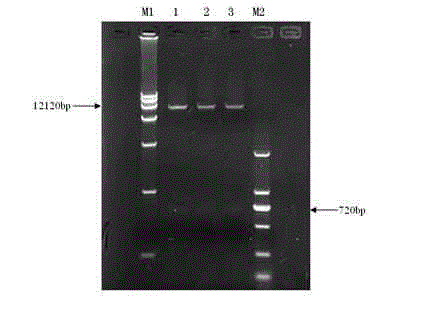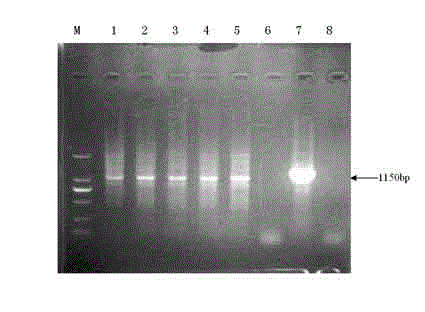Plant RNA (Ribose Nucleic Acid) interference vector for inhibiting lignin from synthesizing, and construction method and application of plant RNA interference vector
An RNA interference and lignin technology, applied in the biological field, can solve problems such as increasing costs and affecting the absorption of nutrients in livestock
- Summary
- Abstract
- Description
- Claims
- Application Information
AI Technical Summary
Problems solved by technology
Method used
Image
Examples
Embodiment 1
[0033] Embodiment 1: alfalfa CCoAOMT Cloning of gene fragments
[0034] 1. Extraction of total RNA from alfalfa
[0035] (1) Take 100mg of young alfalfa tissue, add liquid nitrogen to grind; add 1mL RNAiso Plus to the mortar, let stand at room temperature until the sample is completely melted, and continue to grind until the lysate becomes transparent;
[0036] (2) Transfer the homogenate to a centrifuge tube; centrifuge at 12000 r / min, 4°C for 5 min; take the supernatant and transfer it to a new centrifuge tube;
[0037] (3) Add chloroform (1 / 5 volume of RNAiso Plus) to the supernatant, shake for 15 seconds, and wait for the solution to be fully emulsified, then let stand at room temperature for 5 minutes;
[0038] (4) Centrifuge at 12000 r / min, 4°C for 15 minutes; absorb the supernatant and transfer it to another new centrifuge tube;
[0039] (5) Add an equal volume of isopropanol to the supernatant, mix thoroughly, and let stand at room temperature for 10 minutes;
[...
Embodiment 2
[0052] Example 2: Preparation of Plant RNA Interference Carrier Inhibiting Lignin Synthesis
[0053] The forward nucleic acid fragment and the reverse nucleic acid fragment with corresponding restriction sites obtained in Example 1 were respectively connected to the pMD19-T carrier; Asc I and Swa I double-digest the forward nucleic acid fragment connected to the pMD19-T carrier and the plant expression vector pFGC5941, reclaim the target fragment, connect with T4 ligase, and obtain the intermediate vector pFGC5941-CCoAOMT1; Xba I and Sma I double digest the pMD19-T vector containing the reverse nucleic acid fragment and the intermediate vector pFGC5941-CCoAOMT1, recover the target fragment, connect it with T4 ligase, and construct the plant RNA interference vector pFGC5941-CCoAOMTi that inhibits lignin synthesis.
[0054] The double digestion vector pFGC5941-CCoAOMTi was identified, the results are as follows figure 1 and figure 2 As shown, 2 fragments were obt...
Embodiment 3
[0056] Example 3: Transformation of plant RNA interference vector into Agrobacterium tumefaciens.
[0057] 1. Preparation of Agrobacterium Competent Cells
[0058] Pick a single colony of Agrobacterium tumefaciens and inoculate it in 3ml LB liquid medium; 220 r / min, 28°C, shaking culture to OD 600 =0.5; draw 1.5ml of bacterial liquid into a centrifuge tube, ice-bath for 10min; 30s, discard the supernatant; use 100μl 20mM CaCl per tube 2 suspended for transformation.
[0059] 2. Direct Transformation of Plasmids into Agrobacterium
[0060] Add 10ul of plasmid pFGC5941-CCoAOMTi to 50μl of Agrobacterium competent cells, and ice bath for 30 minutes; put it in liquid nitrogen for 1 minute, and then immediately put it in a 37℃ water bath for 5 minutes; take out the centrifuge tube, add 0.5mlLB, 28℃, 220 Shake culture at r / min for 4 hours; take out the bacterial solution and smear it on an LB plate containing kanamycin, and culture it upside down in an incubator at 28°C. Colo...
PUM
 Login to View More
Login to View More Abstract
Description
Claims
Application Information
 Login to View More
Login to View More - R&D Engineer
- R&D Manager
- IP Professional
- Industry Leading Data Capabilities
- Powerful AI technology
- Patent DNA Extraction
Browse by: Latest US Patents, China's latest patents, Technical Efficacy Thesaurus, Application Domain, Technology Topic, Popular Technical Reports.
© 2024 PatSnap. All rights reserved.Legal|Privacy policy|Modern Slavery Act Transparency Statement|Sitemap|About US| Contact US: help@patsnap.com










